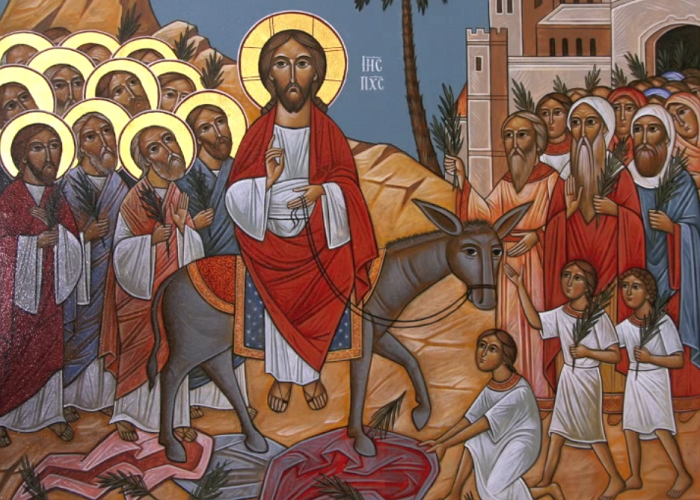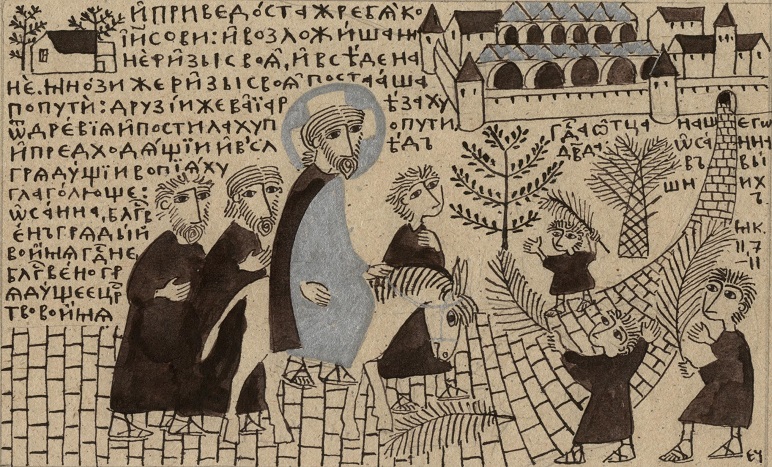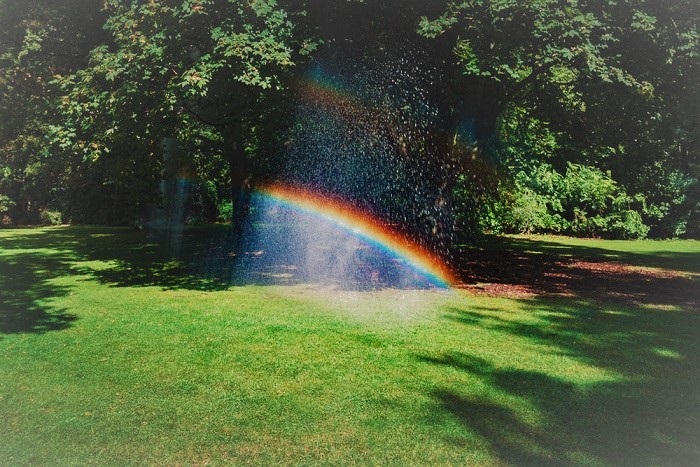
Christians have celebrated the joyful holiday of the Lord’s Entry into Jerusalem since earliest times with exceptional splendor. There isn’t any Christian nation which wouldn’t mark this day with a special worship ritual. Let’s describe some significant features of worship of various Christian denominations and find out how diverse our Christian liturgical traditions and the perception of the Lord’s Entry into Jerusalem can be.
Armenian worship is primarily based on the ancient Orthodox tradition of Jerusalem, which is also the source of our Byzantine rite. This holiday is called the Resurrection of Flowers (całkazard) or the Blessed Sunday (thanks to the words, Blessed is He that cometh in the Name of the Lord.” (Matthew 21:9). The selection of biblical readings of the Matins is surprising: the Armenians read an extract from the Song of Solomon, with the Savior as the Lover and Jerusalem as his Bride. When Jesus enters Jerusalem, He cometh leaping upon the mountains, skipping upon the hills… behold, he standeth behind our wall, he looketh forth at the windows, shewing himself through the lattice. (Song of Songs 2:8, 9). The Vespers is held according to a special rite, which originates in the ancient Jerusalemite procession with palm branches. People gather at the porch by the locked door of the church, and the Vespers is held there. There is an exchange at a certain point during the service between a priest outdoors and a priest indoors, which paraphrases the well-known Gospel story of the Foolish Virgins. Finally, the priest proclaims the verse, “Open to me the gates of righteousness: I will go into them, and I will praise the Lord” (Ps. 118:19). The door springs open, the congregation enters the church, and the Gospel of the holiday is read.

There is a festive procession with palm branches before the Liturgy in the Coptic worship practice, too. All four Gospel accounts of the event are read during the service. After the service, the Copts usually have a memorial service for the deceased, linked to the resurrection of Lazarus.
The Ethiopian practice of celebrating this holiday (the Hosanna Sunday) is extremely well elaborated and full of interesting details. The service starts with handing out palm branches to everyone, and then they read the Epistle to Hebrews, in which the author states that the Lord Jesus Christ is the only High Priest who, [n]either by the blood of goats and calves, but by his own blood <…> entered in once into the holy place, having obtained eternal redemption for us. (Heb. 9:12). It is followed by a procession around the church with singing of special antiphons. All four Gospel accounts of the Lord’s Entry into Jerusalem are read on all four corners of the church. When the procession returns to the church door, only the priest goes into the church, alluding to the Lord in the midst of the congregation, who entered into heaven itself, now to appear in the presence of God for us (Heb. 9:24). Then there is a back-and-forth between the priest in the church and the deacon who stands in the crowd, based on the words of Psalm 24, Lift up your heads, O ye gates; and be ye lift up, ye everlasting doors; and the King of glory shall come in. As soon as the last words of this Psalm are read, the door is opened and all the faithful go inside the church, willing to be sprinkled by the Blood of Christ so as to purify their conscience from futile human efforts and to serve the Living God like they heard in the Epistle. The holiday is later fulfilled in a special Hosanna Anaphora (one of the fourteen anaphoras known to the Ethiopian tradition), which is expressly dedicated to this feast.
The customs and rituals of this holiday in the Western Church appeared and developed long before its schism with the Eastern Church. The Catholic Church still retains some of those traditional rituals.

The holiday of the Lord’s Entry into Jerusalem appeared in the Roman Rite only in the early 8th century. It can be explained by the fact that all Sundays before Easter in the Roman Church were traditionally devoted to the topic of the Passion of Christ, which is mentioned even by Saint Leo the Pope of Rome (See Leo Magn. Serm. 3 // CCSL. 138A. P. 322). The Roman tradition prescribed having a solemn procession with consecrated palm branches from Santa Maria Maggiore to the Archbasilica of St. John Lateran. The procession in small parishes would simply circle the church and stop at the locked church door. Subdeacons would knock at the door with a cross to symbolize that the Passion of Christ opened the entrance into the Kingdom of God for us. The door was opened, and the faithful went into the church while the choir was singing Ingrediente Domino (When the Lord Was Coming) responsory. A solemn mass crowned the celebration. This practice remained almost unchanged for centuries.
The main feature of the holiday in the original practice of the Ambrosian Rite was the return of the Creed by catechumens who, after having spent a long time learning the catechism, ‘returned’, that is, confessed in front of the Church the faith that they had been taught by reading aloud the Creed in a solemn manner. The procession with palm branches appeared later, and was probably borrowed from the Gallican Rite. Back in the 11th and 12th centuries, the Archbishop of Milan would bless palm branches, climb a white horse, and lead the procession toward the Basilica of Saint Ambrose with a cross adorned with palm leaves in his hand. When the procession got to the Basilica, there was a festive Liturgy. It is worth mentioning that the Old Testament reading of that Liturgy was the famous prophecy of Isaiah about the ‘man of sorrows’ who was afflicted for human sins.

The Mozarabic Rite, according to Saint Isidore of Seville († 636) in his work (Isid. Hisp. De eccl. offic. 1. 27 // PL. 83. Col. 763 ff.), is said to have the holiday titled Dominica palmarum (Palm Sunday). This day was the day of pre-baptismal rituals in Spain, like in the Diocese of Milan, which is why this feast was alternatively referred to as ‘Easter Minor’. A unique ritual called Ephphatha was performed by the bishop during the Matins, following a number of exorcisms and anointings. The bishop would stick his fingers, wet with saliva (!), into the catechumens’ ears and touch their nostrils, imitating the Lord who had healed a lame and deaf man this way. Even Saint Ambrose of Milan mentions this ritual in his books. This ritual was followed by the Liturgy and the Return of the Creed. Prior to the Liturgy, they would have a procession with palm branches, previously consecrated on the Holy Table. Some of the antiphons sung during the procession were translated Byzantine chants.
We have explored the practices of Palm Sunday celebrations in Oriental churches and described the ancient liturgical practice in the West. Christian history of church holidays is exceedingly rich. Many ancient rites intertwined and borrowed some elements from each other, thus becoming richer and more profound. Some people may ask, “Why do you think we need to know all that stuff?” At any rate, knowledge of ancient worship traditions helps us to appreciate and love our own tradition, to figure out the logic and meaning of everything that happens in the Church. It is through worship that we realize the immeasurable depth and treasures of our faith – the faith that sustains the Universe.




Very interesting!!!